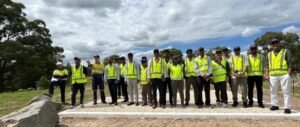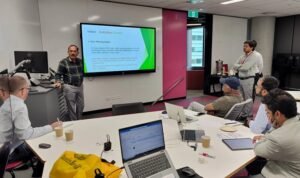Drawing on the success of DRIP II, the “Training Program on Dam Safety and Risk Management in Australia” focused on equipping Indian dam safety professionals with comprehensive knowledge and practical experience in advanced safety practices, focusing on risk management, structural health monitoring, and emergency preparedness. The Program fostered collaboration between Indian and Australian experts, leveraging Australia’s well-established regulatory frameworks, cutting-edge research, and innovative technological solutions to enhance the safety and resilience of dam infrastructure.
AIWC Australia proudly welcomed the second cohort of 15 Indian Dam Safety Officers to Australia for a specialised Dam Safety and Risk Management Training Program led by Distinguished Professor Basant Maheshwari, Director, Australia India Water Centre (AIWC) at School of Science, Western Sydney University.
The program, a collaboration between WSU, AIWC, the Ministry of Jal Shakti (the Federal Water Ministry, Government of India), Dam Safety NSW, Water NSW, the Hunter Water and the Snowy Hydro Corporation, enhanced knowledge exchange and best practices in dam safety.
The two-week training journey began on March 17, 2025.
The diverse cohort of participants included senior officials from India’s Central Water Commission, National Dam Safety Authority, and various state water resource departments.
The training offered a blend of expert-led workshops and immersive field trips to key locations within NSW Australia, including Warragamba Dam, Hunter Water facilities, the State Emergency Service NSW facility in Wollongong, the Cotter Dam, and Snowy Hydro. The program provided participants with valuable insights into Australia’s regulatory frameworks and technological advancements in dam safety.
Key Highlights and Learnings
- Immersive Field Visits: Participants explored Australia’s most significant dam infrastructures, including Warragamba Dam, Cotter Dam, Talbingo Dam, Blowering Dam, and the iconic Snowy Hydro Scheme. These visits provided first-hand exposure to cutting-edge practices in dam safety, innovative structural designs such as fuse gates and roller-compacted concrete dams, sophisticated instrumentation, and advanced monitoring technologies.
- Expert-led Workshops and Discussions: The training featured comprehensive workshops by leading authorities, including Dam Safety NSW, WaterNSW, Hunter Water Corporation, Banzi Consulting, State Emergency Service (SES), and Snowy Hydro. These workshops emphasised critical aspects of emergency preparedness, robust risk mitigation strategies, state-of-the-art technology integration, and the pivotal role of stakeholder and community engagement in maintaining dam safety and sustainability.
- Daily Reflections and Synthesis: Each day concluded with detailed reflective sessions, allowing participants to consolidate their observations, learnings, and insights. This ensured a comprehensive understanding of each day’s outcomes and strengthened the practical applicability of lessons learned.
- Transdisciplinary Collaboration: Throughout the training, a primary emphasis was placed on promoting a holistic and integrative approach by bringing together expertise from diverse fields – engineering, environmental science, economics, sociology, and policymaking, to address the multifaceted challenges of dam safety management effectively.
SUIP Presentations – Knowledge to Action
On the final day, participants presented their Situation Understanding and Improvement Projects (SUIP), synthesising their extensive learning journey. These presentations highlighted promising practices currently implemented in India, identified gaps, and proposed strategic opportunities for further collaboration and knowledge exchange between Australia and India, underlining the training’s tangible outcomes and future potential.
This initiative has laid a robust foundation for ongoing bilateral engagement, facilitating future knowledge and expertise exchanges. Participants are now equipped with actionable insights and strategies to advance dam safety and risk management practices in India.
The dedication, collaborative spirit, and enthusiasm exhibited throughout this training program added to a positive learning environment. We eagerly anticipate witnessing the transformative outcomes and the lasting positive impacts these valuable lessons will have on India’s dam safety landscape and water resource management.
This initiative strengthens global collaboration in dam safety and risk management, ensuring more resilient and sustainable water infrastructure for future generations.


